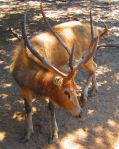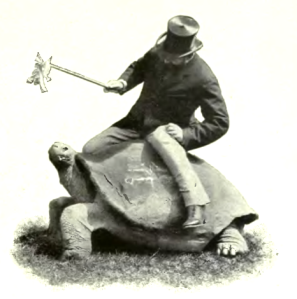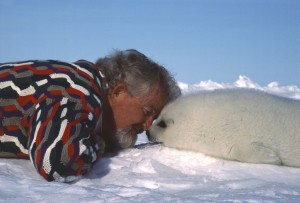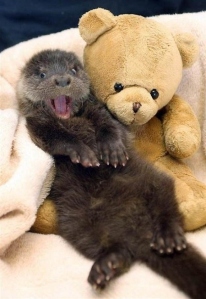Humans have been around for about 200,000 years–longer if we include other members of our genus, such as Homo Erectus–and it took us about 199,800 of those years just to make one billion of us. It took about 120 years to make the second billion of us, and 100 years to make the next six billion.
When will we stop? Will our population stabilize, keep climbing, slowly decline, or suddenly crash? I have no idea. I do know, however, that humanity’s growth–and industrialization–shows no sign of slowing in the short term, putting increasing pressure on the other species we share our planet with.
I like animals. I don’t want elephants or panda bears to go extinct. But how much good can conservation efforts do in a world of increasing numbers of hungry people who also want to use the animals’ habitats?
Since there is nothing I can do about the number of people in the world, I propose a different solution: mass domestication.
Wikipedia estimates that there were about 60 million buffalo (American bison) in the US in 1800. Today, there are about 90 million cattle. Domesticated cattle far outnumber their ancestral species, the auroch. Dogs outnumber wolves. Corn has gone from a dinky little plant growing in Mexico to one of the world’s most common plants. Even rats and pigeons have benefited from their association with man.
How many species could be preserved by mutually-beneficial domestication?

Many species of deer or other large herbivorous herd animals could be raised for meat, such as the Pere David’s deer, virtually extinct in the wild:
This semiaquatic animal prefers marshland, and is native to the subtropics of China. It grazes mainly on grass and aquatic plants. …
In the late 19th century, the world’s only herd belonged to Tongzhi, the Emperor of China. The herd was maintained in the Nanyuan Royal Hunting Garden in Nan Haizi, near Peking.[14] In 1895, one of the walls of the hunting garden was destroyed by a heavy flood of the Yongding River, and most of the deer escaped and were killed and eaten by starving peasants. Fewer than thirty Père David’s Deer remained in the garden. Then in 1900, during the Boxer Rebellion, the garden was occupied by troops and the remaining deer were shot and eaten, leaving the Père David’s deer extinct in its native China.[1]
I hear it’s difficult to farm or raise cattle in marshlands, so why not raise marsh-adapted deer?
The scimitar oryx, similarly extinct in the wild, has lovely horns and lives comfortably in large herds in dry areas.

The Axolotl is an incredible “amphibian” that never develops lungs and spends its entire life underwater:
As of 2010, wild axolotls were near extinction[6] due to urbanization in Mexico City and consequent water pollution. They are currently listed by CITES as an endangered species and by IUCN as critically endangered in the wild, with a decreasing population. Axolotls are used extensively in scientific research due to their ability to regenerate limbs.[7] Axolotls were also sold as food in Mexican markets and were a staple in the Aztec diet.[8]
 Axolotls come in a variety of lovely colors and range in appearance from the cute to the intimidating.
Axolotls come in a variety of lovely colors and range in appearance from the cute to the intimidating.
And if you want an axolotl in your aquarium, perhaps you’d also be interested in an Alabama cave fish.
 Governments, in order to symbolize their long, peaceful rule, could adopt tortoise mascots, sheltering them on official grounds (there’s plenty of space around the White House for a herd of turtles.)
Governments, in order to symbolize their long, peaceful rule, could adopt tortoise mascots, sheltering them on official grounds (there’s plenty of space around the White House for a herd of turtles.)
Imagine a future in which tortoise races are an official function of government. Or diplomats engage in slow-motion jousting matches.
Since turtles and tortoises are temperature sensitive, each government would want to highlight a local species, not an imported one (unless no local species were available.)

The Brazilian merganser:
is a duck in the typical merganser genus. It is one of the six most threatened waterfowl in the world with possibly fewer than 250 birds in the wild and currently 4 kept in captivity at 2 different Brazilian locations. The origin of its name is from its long, sharp-edged beak that has a great number of teeth-looking edges.
I’ve eaten duck eggs. They’re tasty–a lot like chicken eggs, actually.
 Pygmy elephants, rhinos (if you could breed a non-grumpy variety) and giraffes–imagine delicately proportioned miniature giraffes being taken for a walk through Central Park by their gliteratti owners.
Pygmy elephants, rhinos (if you could breed a non-grumpy variety) and giraffes–imagine delicately proportioned miniature giraffes being taken for a walk through Central Park by their gliteratti owners.
Flightless birds like the kakapo have been decimated by the introduction of invasive hunters like cats. Since they cannot fly, they seem already better suited to being pets than flying birds like cockatoos.
Most primates seem too intelligent for domestication–they’d use their thumbs and smarts to get into trouble–but maybe a few, like lemurs, could make good companions.
Pangolins, seals, and otters are obviously high on my list:

Obviously this post has been somewhat lighthearted, and there are probably good reasons why some of these animals actually aren’t well-suited to domestication.
But I am also serious; I would far rather live in a world with miniature pet pandas and giraffes than a world where these animals have gone extinct.
If we’re stuck on this planet–and it looks like we are–let’s make it a pleasant place to live.
Which animals do you think we should domesticate?



[…] Source: Evolutionist X […]
LikeLike
In the realm of the already domesticated, if I had the space and the money, I’d totally want a Siberian silver fox…
I remember once in middle school science class getting into an argument with a proto-SJW student about farming trees for paper… Basically, his cause du jour was clear-cutting forests, and I pointed out how paper and a lot of wood products actually came from farmed trees that were carefully maintained, not clear-cutting virgin rain forests or such. He then went onto some rant about how that was still bad, because… I don’t remember why, but it was the usual thing about how it wasn’t really natural… (How I wish I’d known about the recent finds about pre-Colombian civilizations in the Amazon farming and clearing forests and having semi-domesticated tree species… I’d already done too much reading about Aztec, Mayan, and Inca human sacrifice to go along with the Noble Savage Native American lessons… Did I mention teachers didn’t always like me?)
LikeLike
I can understand middle-schoolers spouting off about a topic they feel emotional about but aren’t very well-informed on. Tree farms are really lovely places, though. Full of trees. It’s really hard to imagine a more environmentally-friendly operation. “Look, we plant trees! Isn’t that what you want?”
LikeLike
It gets really awkward if you point out that New England has significantly more trees now than it did 100 years ago… One thing that quickly made me suspicious of environmentalism as a movement was how as soon as something is actually fixed to a reasonable degree (like, say, water pollution even 20 years ago, or the ozone or smog outside of China now…) interest in the topic just tanks, rather than being celebrated or at least pointed to as evidence that some amount of regulation might be a useful thing… Obviously, some people do, and I’ll usually give those people a more serious listening than the ones who are in a hurry to move on to the next cause… (I’m not counting people who, say, have worked on cleaning up river A, and then set about getting river B cleaned up… Or, say, 90% of North American rivers are now clean, so let’s focus on rivers in Asia, starting with XYZ… But, like, “We Need Clean Rivers. That’s boring now, so, um, Save The Burmese Pythons!” (God, I hope no one really picks up that last cause…))
LikeLike
Too true. Sadly, it seems about as likely to work out as people getting serious about genocide, but one can hope.
LikeLike
Which animals do you think we should domesticate?
Gliteratti like the one in Central Park.
LikeLike
Apparently giant tortoises are so delicious scientific specimens had difficulty surviving the journey on sail ship. Perhaps we should try farming them.
LikeLike
I would opt for depopulation and domesticated wild life
LikeLike
Bears. Breed them to be a little smaller, a little softer, and a lot nicer.
Might threaten the place of the dog though.
LikeLike
Tiny pet pandas for everyone!
Realistically, though, I think the dog’s pack nature would help it retain its place.
LikeLike